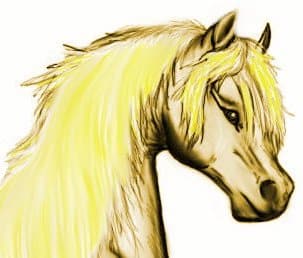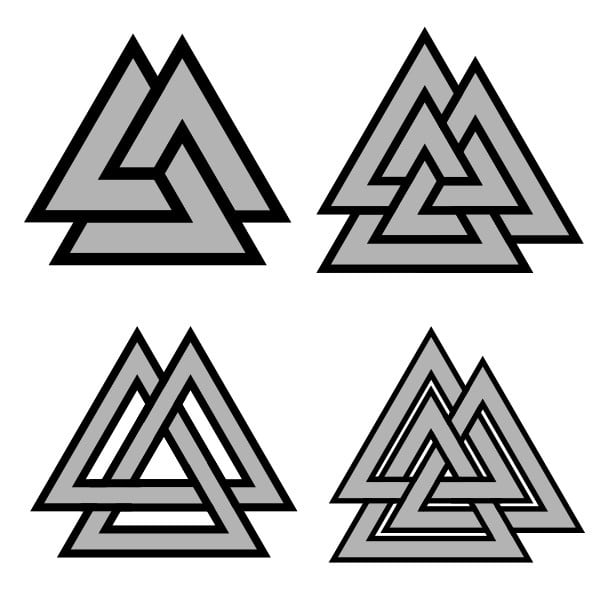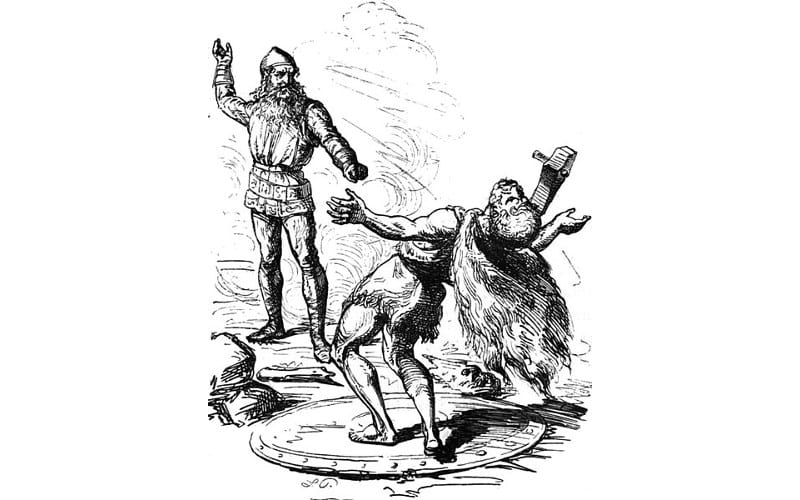There are many jotnar, or giants, in Norse mythology, and a few of them are described as impossibly strong and mighty. Among them, Hrungnir is possibly the mightiest of all, at least except for Ymir, the first of the jotnar and arguably the biggest and strongest.
When writing about Hrungnir, there is a side to him that I think deserves exploring. That is his likely connection with the symbol commonly known as Valknut. I believe the name is a modern invention. Instead I think the name of that symbol is in-fact “Hrungnirs’ heart”.
He is actually mentioned quite often in various pieces from ancient Norse mythology. I will include all mentions here and discuss how it might point to him being a rather central figure. He is certainly worthy of mention for more than his ill-fated duel with Thor. It did not end well for him.
Hrungnir Key Facts
| Keyword | Fact |
|---|---|
| Parents | Unknown |
| Partners | None known |
| Siblings | None known |
| Offspring | None known |
| Tribe | Jötun |
| Old Norse name | Hrungnir |
| Other names | None known |
| Ass. Powers | Strength, Endurance |
| Ass. Animal | Horse (specifically, his steed Gullfaxi) |
Name and Etymology
The name Hrungnir, which is the same as in Old Norse, is reflective of the giant’s formidable nature. While the etymology and meaning is not entirely clear, it’s believed to derive from roots suggesting “brawler” or “stormer”.
This fits his character as one of the strongest jötun and enemy of the gods. Kennings, poetic phrases used to describe figures and objects indirectly, are usually connected with his immense strength or his role as a formidable opponent to Thor.
Hrungnir Origins and Background
Little, nothing really, is ever revealed about Hrungnir’s lineage. Instead, mentions of him focus on his deeds rather than his background. Unlike many figures in Norse mythology, Hrungnir’s parents or siblings, if any, are not mentioned in the surviving texts. This lack of familial background emphasizes his role as a symbol of raw strength and the chaotic power of the jötnar.
Family and Relationships
Hrungnir’s interactions with the gods, especially Thor, are central to his mythos. His lack of mentioned partners or offspring in the myths instead focuses the narrative on his role as an adversary.
This is actually somewhat unusual as most of the jotnar are mentioned as having at least one or two closer familial ties. Hymir is the (possibly adopted) father of Tyr, and husband/consort to Tyr’s mother. Suttung, of the Mead of Poetry, has a brother and the daughter Gunnlöd. Thjazi is the father of the jötun turned goddess Skadi. The list goes on, and most of them typically have some family. However Hrungnir is a lone antagonist, challenging Thor to a duel, setting up a fight for the ages.
The Giant Steed Gullfaxi

While lacking any close family connections, at least that we know today, Hrungnir did seem attached to his horse Gullfaxi. The whole story of Hrungnir really starts when Odin is out riding on Sleipnir, and meets a jötun and his impressive steed.
They each boast about their horses and, true to form, Odin claims Gullfaxi would be no match for Sleipnir. He even goals as far as saying he would wager his head on this. From the recounting made of this in Snorri’s Skaldskaparmál it’s unclear if the challenge is accepted or not. Either way, Hrungnir chases after Odin, wanting to teach him a lesson, and/or chop his head off.
Gullfaxi proves to be stronger than maybe Odin thought, but riding Sleipnir, he manages to reach the safety of Asgard, Hrungnir right on his heels. Calamity soon ensues and in the end, after Hrungnir’s defeat by Thor, he gives Gullfaxi to his son Magni who had saved him.
Role And Depiction
In the myths, Hrungnir is depicted as among the strongest of the jötnar. Basically he is embodying the colossal and untamed forces of nature that the gods often strive to overcome or harness. However, his role is more than a mere antagonist; he is a measure against which the valor and strength of the gods, particularly Thor, are tested. Hrungnir’s personality, as gleaned from the tales, is that of a proud and fierce warrior, eager to prove his might. However, he is ultimately bound by the same fates that govern all in Norse cosmology. The Nornes had sealed his fate already at birth, Thor is just the instrument of his inevitable demise.
I believe though that he might have been held in higher regard than what is evident today. This is because I think that the Vikings actually named one of their most iconic symbols after him. Spoiler alert, it’s the symbol commonly known as the Valknut.
The Hrungnir’s Heart Symbol

I have actually written a whole article on the Valknut-Hrungnir’s Heart symbol which I recommend you check out. The short version is that the symbol with the three interlocking triangles is well documented in various Viking Age finds. However, the name, Valknut, is a modern invention, and can’t be found in any ancient text.
On the other hand, there is a symbol which Snorri Sturluson refers to as apparently well known at the time. This is found in the Skáldskaparmál chapter 17, part of the Prose Edda, and goes like this:
“Hrungnir had a heart that is renowned, made of solid stone and spiky with three points just like the symbol for carving called Hrungnir’s heart has ever since been made.”
Translation by Anthony Faulkes, Professor of Old Icelandic at the University of Birmingham.
So, on the one hand we have a well known symbol, found on both runestones and ancient manuscripts, but we don’t know the name exactly. On the other hand we have a name, for a spiky, three pointed symbol called Hrungnir’s heart, but somehow the connection between the two has been unclear.
This seems to me to be so obvious it baffles me how people will call it the Valknut as I think this is obviously the Hrungnir’s heart symbol.
Symbol of Bravery and Valor
The exact meaning the ancient Vikings associated with the Hrungnir’s heart is not entirely clear. However, based on the mention in Skaldskaparmal, it seems Hrungnir, with his heart of stone, was brave and unwavering when facing Thor. This is especially so since he is compared to Mökkurkálfi, the clay giant the jotnar made. His heart was pounding and he was deathly afraid, to the point of actually wetting himself.
The symbol is often found in situations associated with death, so it might have been as a sign of bravery in the face of death. However, it could maybe be a sign of impending death, and of someone soon going to the next realm. With no hard facts or old manuscripts to lean on it’s impossible to know.
Myths and mentions of Hrungnir
The duel between Hrungnir and Thor is the most famous tale involving the jötun. This myth, rich in symbolism and dramatic action, highlights the themes of strength, courage, and the inevitable consequences of pride and rivalry.

It is only found in the Skaldskaparmál part of Snorri’s Prose Edda. It is in chapter XVII – Haustlöng and Thor’s Duel with Hrungnir. The Haustlöng is actually an older poem, which Snorri includes in the chapter, seemingly his source for the myth. However Snorri’s recounting and the Haustlöng poem varies in several parts so Snorri likely had other sources to draw from as well.
Nafnaþulur – List of Names
Hrungnir is also mentioned among the jotnar listed in the Nafnaþulur, the last part of the Skaldskapramál containing lists of names etc. His name comes among the other jotnar in the the sixth verse.
Giants I
- I will make a listing
of the giants;
Ymir, Gangr and Mímir,
Iði and Þjazi,
Hrungnir, Hrímnir,
Hrauðnir, Grímnir,
Hveðrungr, Hafli,
Hripstoðr, Gymir.
Harbardsljod
Another mention of Hrungnir, to show how prevalent his references are, come in the Poetic Edda poem Harbardsljod. In it Thor meets a mysterious ferryman who refuses to take him across a sound. Instead he insults Thor in various ways, and it is understood that it is indeed Odin in disguise.
Some way into their exchanging of insults, there are two mentions of Hrungnir.
Harbard said:
- “I’ll stand here | and wait for you.
Since Hrungnir died you have met | no man as fierce.”
Thor said:
- “You seem eager to talk | about how I fought Hrungnir,
the arrogant giant, | with a stone head.
But I defeated him, | and laid him out in front of me.
What did you, Harbard, do meanwhile?”
Here too you find that they mention him as a fierce opponent, and possibly the strongest one Thor has ever faced.
Sigrdrífumál
Yet another mention of Hrungnir is found in a partially damaged poem in the Codex Regius version of the Poetic Edda. Again it is in relation to Thor being the killer of Hrungnir, confirming in part how important or central an event that is.
- He bade write on the shield | before the shining goddess,
On Arvak’s ear, | and on Alsvith’s hoof,
On the wheel of the car | of Hrungnir’s killer,
On Sleipnir’s teeth, | and the straps of the sledge.
It is from a section of the poem that covers runes, and here apparently they are written on the wheel of the car of Hrungnir’s killer, meaning Thor.
A Lost Myth About Hrungnir
One of the most interesting mentions I think is one found in the Skaldskaparmal, vaguely referring to him. It is found in chapter “XLVIII – On paraphrasing weapons”. Here there are a number of ways a skald can refer to weapons, and the below one is how a shield can be “the sole-blade” of Hrungnir. However, he isn’t referred to by name, but instead he is called “Thrudr’s thief”.
Blade of Hrungnir’s Foot-Soles, as Bragi sang:
Wilt hear, O Hrafnketill,
How I shall praise the Sole-Blade
Of Thrúdr’s thief, stain-covered
With skill, and praise my king
This mention, and it’s implications are rather profound. There is obviously some other myth where Hrungnir kidnaps Thrud, ferocious warrior daughter of Thor. However, nowhere else in the known Norse mythos is such a reference made.
Thor might have had a very good reason for wanting to kill him, besides his normal habit of seeking out and battling jotnar. There is a small possibility that this myth is somehow associated with some event mentioned in the poem Alvissmál. In that poem, the dwarf Alviss (All-wise), refers to something he did where he then was promised Thrud’s hand in marriage. Whatever he did, that to is in some other lost myth. As both involve Thrud, it’s tempting to connect them, but that would be pure speculation.
Frequently Asked Questions
Hrungnir was renowned for his immense strength and his duel with Thor, representing the raw power of nature in conflict with the divine.
While not described with specific magical weapons, Hrungnir’s sheer strength and his stone heart were his most notable attributes.
His stone heart symbolizes unyielding strength and resilience, as well as the jötnar’s deep connection to the natural and earthen elements.
Thor ultimately defeated Hrungnir, but the giant’s leg fell on Thor’s neck, trapping him until Thor’s son, Magni, lifted it off.
Hrungnir’s tales teach about the balance between chaos and order, the importance of strength and courage, and the inevitability of fate.
He is often depicted in battle with Thor, symbolizing the clash between the natural world and the divine order.
Featured Image Credit: Ludwig Pietsch (1824-1911), Public domain, via Wikimedia Commons

Thanks for this I’ve been wanting some detail on the Valknut / Hrungnir’s Heart connection for a while.
Can I also ask: the jotnar are described here as “giants”. Are these the “frost giants” to be fought at Ragnarok? How many kinds of giants are there?
Hey Launce, great that you liked my deep-dive into Hrungnir. You should check out the post I did on the Valknut symbol as well 😉 The term “giant” as used for the jötun is really not that accurate as there were several types of jotnar. They are sometimes described as fire giants, frost giants or plain giants, however, it’s worth remembering that many of the lovers (or wives) of the gods come from the jotnar, like Gerd, Gunnlöd, Gaia, and others. They were human-like, in form, and definitely not giants, then suddenly in their direct family you have giants/trolls for many heads and hidious looks. As is so often the case in Norse myths, there is a fluidity to the stories and “facts” and you are often hard pressed to nail down the “facts”.
/marius